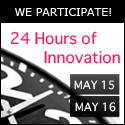Apr30
Andrea Meyer
Point: Special events like marathons (for bloggers & innovators) create a focal  point of energy, creativity, and idea exchange.
point of energy, creativity, and idea exchange.
Story: For 24 hours starting 10am CET May 15, bloggers around the world will share their insights about innovation. Each blogger gets a timeslot, and the action will move from blog to blog. My timeslot is 8:15 EDT on Friday, May 15, and the full line-up will be listed at the Board of Innovation.
This marathon provides a great way to explore innovation from many people’s perspectives. I’m looking forward to the exchange of ideas. Because each blogger selects their own topic to write about, it will be interesting to see what patterns, trends and sparks of creativity emerge.
Action:
- Visit the 24-hour marathon of blogs to gain insights
- If you blog about innovation, you can sign up for a time-slot here
Innovation
Apr27
Andrea Meyer
Point: You don’t have to be the originator of an idea to succeed with it.
Story: Sam Walton didn’t invent discount retailing. Instead, he learned of the idea from an article about two Ben Franklin stores in Minnesota trying self-service. At the time, self-service retail was a brand new concept. Previously, customers came to a counter and the full-service clerks helped the customer by picking items from the shelves behind the counter. Upon reading the article about this new concept, Sam went to investigate. “I rode the bus all night long to two little towns up there — Pipestone and Worthingon,” Walton recounts in his autobiography. “They had shelves on the side and two island counters all the way back. No clerks with cash registers around the store. Just checkout registers up front. I liked that. So I did that, too,” In 1950, Walton’s Five and Dime was the third self-service variety store in the country.
But Sam didn’t simply imitate this one discount retailing idea. He continued to toy & tinker with it and improve it, even as it grew and became successful. He kept his stores well stocked with lots of items, stayed open late, bought goods in bulk to reduce costs, and pioneered communications and logistics technologies to maintain his everyday low price strategy. “As good as business was, I never could leave well enough alone, and, in fact, I think my constant fiddling and meddling with the status quo may have been one of my biggest contributions to the later success of Wal-Mart.”
Howard Gardner, Professor of Cognition and Education at the Harvard Graduate School of Education, sees this style of constant innovation as key characteristic of creative people. He says, it’s not a flash-in-the-pan, one-time-only thing. it’s a whole style of existence. People who are creative are always thinking about the domains in which they work. They’re always tinkering. They’re always saying, “what makes sense here, what doesn’t make sense? And if it doesn’t make sense, can I do something about it?”
Action:
- Be open to the new and different — seek out odd-ball business practices in out-of-the-way places
- Study how others do what they do, why they do it, and how it can work in your situation
- Adopt and adapt those discovered ideas and keep tweaking the ideas
For more information: Sam Walton: Made In America and Creative Spirit by Daniel Goleman, Paul Kaufman, and Michael Ray.
Case study, Creativity, How-to, Innovation, Strategy
Apr21
Andrea Meyer
Point: Companies can encourage innovation through employee contests
Story: The previous post on Harrah’s Entertainment generated some great discussion, particularly around EMC’s “innovation-by-contest” as one approach to generating innovations. Some companies (e.g., Harrah’s, HP) use themes to guide their employee-submitted innovations, and some companies (e.g., EMC) do not.  This prompted me to ask Wharton Professor Karl Ulrich, author of the forthcoming Innovation Tournaments (Harvard Business School Press, May 14, 2009) about his experiences with innovation contests. In his book, Ulrich uses the metaphor of a tournament to explore how ideas vie for attention and resources during the innovation process. Ulrich’s central metaphor is that companies use figurative or literal tournaments to progressively filter incoming ideas through a series of hurdles or gates during research, development, and new product introduction. At last week’s Silicon Flatirons‘ conference, I asked Karl about his view on the theme-based approach compared to the wide-open approach for an innovation contest. Ulrich recommended a wide-open approach for the first phase, saying that the wide-open approach might show clusters of idea suggestions on a new topic. He cited a cosmetics manufacturer with whom he’s worked. The cosmetics manufacturer’s contest got a numerous unexpected suggestions for foundations (make-up) for young people — an new area that the company decided to explore further. He added that many companies mistakenly try to fund too many projects — not narrowing the funnel fast enough.
This prompted me to ask Wharton Professor Karl Ulrich, author of the forthcoming Innovation Tournaments (Harvard Business School Press, May 14, 2009) about his experiences with innovation contests. In his book, Ulrich uses the metaphor of a tournament to explore how ideas vie for attention and resources during the innovation process. Ulrich’s central metaphor is that companies use figurative or literal tournaments to progressively filter incoming ideas through a series of hurdles or gates during research, development, and new product introduction. At last week’s Silicon Flatirons‘ conference, I asked Karl about his view on the theme-based approach compared to the wide-open approach for an innovation contest. Ulrich recommended a wide-open approach for the first phase, saying that the wide-open approach might show clusters of idea suggestions on a new topic. He cited a cosmetics manufacturer with whom he’s worked. The cosmetics manufacturer’s contest got a numerous unexpected suggestions for foundations (make-up) for young people — an new area that the company decided to explore further. He added that many companies mistakenly try to fund too many projects — not narrowing the funnel fast enough.
Action:
- Leverage employees’ knowledge of markets or technologies to spawn unexpected revolutionary or evolutionary innovations (e.g., EMC’s contest)
- Cluster the wide-open ideas by similarity, to create or modify themes or spot unexpected opportunities
- Use employees’ distributed knowledge to help focus attention on the best ideas (e.g., Harrah’s voting portal)
Case study, How-to, Innovation, Strategy
 point of energy, creativity, and idea exchange.
point of energy, creativity, and idea exchange.
 This prompted me to ask Wharton Professor
This prompted me to ask Wharton Professor 








